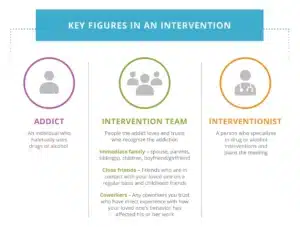What is an Addiction Intervention ?
An Addiction Intervention can be a process or a social gathering. Families can hold their own intervention in their own home or at a neutral location, such as a healthcare center or unused office space. A professional interventionist will help families decide which location will be most beneficial to the addict and the family. During the intervention, family members read letters from the addict, detailing the hurts that have come from their addiction. They can also read the letters written by a loved one who lost a loved one due to the addict’s drug abuse.
Interventionists
A family intervention is conducted in the home of the addicted individual or in a neutral location such as a church or healthcare center. An interventionist can help determine the best location for the intervention. The intervention team may read letters from the addict detailing the hurts they have suffered. Interventionists can also offer the family suggestions on how to conduct the intervention. The family must be able to stay calm during the intervention. After the family and addict agree on the location, the interventionist will present the family and addict with three treatment options.
The first step in the intervention process is identifying the addiction. The addiction is often so widespread that the individual is largely oblivious to the problems he or she has created for himself or herself. In such cases, a family may consider hiring an interventionist to help them find treatment. Many interventionists are certified through the Association of Intervention Specialists, the Family First Interventions, or the Network of Independent Professional Interventionists. The interventionists you select should understand your needs and have a good rapport with the addicted individual.
If you need to hire an interventionist, you may be able to find one through referrals from family members or from a treatment center. If you are unable to find a good match through your friends and family, check the Association of Intervention Services’ member directory. There, you can browse the list of certified interventionists. Make sure you find someone you’re comfortable with and is able to provide an intervention without taking away responsibility. Also, make sure the interventionist you select has a liability insurance policy.
Process
A substance abuse intervention is a method used to help an individual stop using substances and start recovery. The process involves expressing care and making explicit demands that the person seek help for their problem. Depending on the situation, different interventions may follow different stages. Typically, an interventionist is responsible for planning the intervention, and a team of family and friends is formed. The planning stage determines the timing and content of the intervention. A focus on love and acceptance is encouraged throughout the intervention.
There is no one universal definition for process addiction. Process addiction is a compulsion to engage in a specific activity over. The behavior often has negative consequences on physical, social, and financial well-being. Ultimately, an individual may have trouble meeting his or her responsibilities. Process addictions can have devastating consequences on a person’s life, so they need to be treated with professional help. Haven House is one such professional recovery center.
While interventions may be appealing, they are unlikely to work for most people. Addiction is a complex interaction of nature and nurture. Individuals may not recognize the underlying issues that contribute to the behavior and therefore be unaware of them. A trained professional can help the individual make the right decision by guiding him or her through the assessment process. The American Society of Addiction Medicine has outlined a detailed assessment process that provides a systematic approach to individualized assessment and outcome-driven treatment plans.
Those undergoing treatment for addiction often undergo a detoxification process, which reduces withdrawal symptoms. Individuals may also receive counseling to re-program their behavior and attitudes. Sometimes, an individual may required to undergo a six to 12-month rehabilitation program and live in supervised housing. Medications are prescribed to manage prolonged withdrawal symptoms and can even support a person’s sobriety. It is important to note that an addiction treatment center is different from a residential drug treatment facility.
Education
Substance abuse education is an important part of preventing and treating substance use disorders. It helps increase awareness of the negative effects of substance use and can begin early in life, such as in preschool. It can also decrease risk factors that lead to later substance misuse. It is crucial to choose the appropriate age for the educational program and to tailor it to the learner’s level. There are many types of education, including online and in-person programs.
The goal of education for addiction intervention is to help the addict understand the gravity of the problem and what he or she has done. Identifying enabling behaviors is essential to treating the addiction and preventing relapse. Enabling behavior can take many forms, and family members are often common enablers. By providing information on treatment options and other resources, education can be a helpful tool for intervention professionals. Here are three ways to benefit from education for addiction intervention:
The first step to treating addiction is educating the public about substance abuse and how to identify warning signs. Drug education will help individuals understand the harmful effects of substances and how they impact the body and mind. Information about the dangers of using substances is essential for preventing addiction, and it can help individuals understand how to best support someone who has an addiction. It also helps prevent future drug problems. By providing education to the general public, these programs can help reduce the risk of addiction for all individuals.
An education for addiction intervention should include reading about the disease itself and how the disease works. Knowledge of the disease and its impact will increase a person’s motivation to quit. It will also help them achieve lifelong sobriety. Education for addiction intervention should involve a professional interventionist. Education for addiction intervention can help a person overcome addiction and lead a fulfilling life. However, if it’s not possible for the addict to learn about his own disease, education can also help.
Cost
A basic addiction intervention costs between $1800 and $2,000, although more extensive interventions can be more costly. Interventions not covered by insurance, so you should check with the provider you plan to use before making the financial commitment. However, if you feel comfortable paying the fees up front, an interventionist may be the right option. A few things to consider when choosing a provider include the fee structure, the services offered, and the type of intervention they will be conducting.
Hiring a professional interventionist. Although this is the most expensive option, it is the one with the best chance of success. In addition, you will have to pay for travel and lodging costs if the interventionist must travel to the client’s location. This cost may be included in the overall price, though. Some interventionists charge extra for lodging and airfare. The price of an intervention will depend on the type of intervention and whether the interventionist will be flying to the client’s location.
The costs of substance use disorders can be expensive as long as the person continues to abuse substances. Those costs go well beyond the cost of the substance itself. They impact an individual’s physical health, as well as their relationships with other people. While the cost of addiction interventions is high today, the combined cost of continuing substance abuse will likely be higher. Hence, an intervention is worth the investment for the well-being of a loved one and the community.
A good rehab will offer various financing options. Some programs are covered by health insurance and others by private and employer-sponsored insurance plans. For those without insurance, the costs may be higher. However, the Affordable Care Act has provided new options for coverage of rehab. Although many Americans still don’t have insurance, it doesn’t cover all of the expenses. Fortunately, rehab prices have decreased in recent years. There are several different ways to cover the costs of addiction treatment.
Signs of a successful intervention

Whether the intervention is for a family member or for a friend of the addict, there are many signs to look for. Using a professional interventionist will help keep the conversation calm and positive. It’s important to remember that the goal of the intervention is to help the addict and not to make the situation worse for anyone. With a professional interventionist, accusations and other negative feelings will be kept out of the equation. Instead, the focus will be on the long-term recovery of the addict.
The team of interventionists should prepare the entire process before presenting the plan. The process should be well-planned and without any spontaneity. Avoid making accusations or placing blame. Instead, try to focus on the positives of the addict’s behavior. The person will be more likely to accept the intervention if they understand the effects of addiction on their family. It’s important to note that addiction is a disease that can be treated with a comprehensive rehabilitation program and detoxification.
Once the team is formed, they must research treatment options and prepare a speech that will be delivered in a calm and unbiased manner. The intervention team must composed of people with a positive influence on the addict’s life. Avoid involving judgmental or emotional abusive people. If the intervention is unsuccessful, consider hiring a professional interventionist who will set the tone and help the team with the speech. Make sure to do research on professional interventionists and learn their strategies for a successful intervention. Make sure not to minimize the trauma experienced by the addict.

